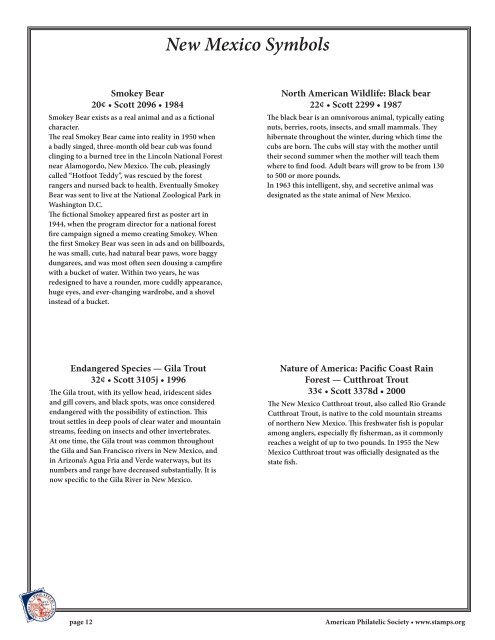New Mexico - American Philatelic Society
New Mexico - American Philatelic Society
New Mexico - American Philatelic Society
Create successful ePaper yourself
Turn your PDF publications into a flip-book with our unique Google optimized e-Paper software.
<strong>New</strong> <strong>Mexico</strong> Symbols<br />
Smokey Bear<br />
20¢ • Scott 2096 • 1984<br />
Smokey Bear exists as a real animal and as a fictional<br />
character.<br />
The real Smokey Bear came into reality in 1950 when<br />
a badly singed, three-month old bear cub was found<br />
clinging to a burned tree in the Lincoln National Forest<br />
near Alamogordo, <strong>New</strong> <strong>Mexico</strong>. The cub, pleasingly<br />
called “Hotfoot Teddy”, was rescued by the forest<br />
rangers and nursed back to health. Eventually Smokey<br />
Bear was sent to live at the National Zoological Park in<br />
Washington D.C.<br />
The fictional Smokey appeared first as poster art in<br />
1944, when the program director for a national forest<br />
fire campaign signed a memo creating Smokey. When<br />
the first Smokey Bear was seen in ads and on billboards,<br />
he was small, cute, had natural bear paws, wore baggy<br />
dungarees, and was most often seen dousing a campfire<br />
with a bucket of water. Within two years, he was<br />
redesigned to have a rounder, more cuddly appearance,<br />
huge eyes, and ever-changing wardrobe, and a shovel<br />
instead of a bucket.<br />
North <strong>American</strong> Wildlife: Black bear<br />
22¢ • Scott 2299 • 1987<br />
The black bear is an omnivorous animal, typically eating<br />
nuts, berries, roots, insects, and small mammals. They<br />
hibernate throughout the winter, during which time the<br />
cubs are born. The cubs will stay with the mother until<br />
their second summer when the mother will teach them<br />
where to find food. Adult bears will grow to be from 130<br />
to 500 or more pounds.<br />
In 1963 this intelligent, shy, and secretive animal was<br />
designated as the state animal of <strong>New</strong> <strong>Mexico</strong>.<br />
Endangered Species — Gila Trout<br />
32¢ • Scott 3105j • 1996<br />
The Gila trout, with its yellow head, iridescent sides<br />
and gill covers, and black spots, was once considered<br />
endangered with the possibility of extinction. This<br />
trout settles in deep pools of clear water and mountain<br />
streams, feeding on insects and other invertebrates.<br />
At one time, the Gila trout was common throughout<br />
the Gila and San Francisco rivers in <strong>New</strong> <strong>Mexico</strong>, and<br />
in Arizona’s Agua Fria and Verde waterways, but its<br />
numbers and range have decreased substantially. It is<br />
now specific to the Gila River in <strong>New</strong> <strong>Mexico</strong>.<br />
Nature of America: Pacific Coast Rain<br />
Forest — Cutthroat Trout<br />
33¢ • Scott 3378d • 2000<br />
The <strong>New</strong> <strong>Mexico</strong> Cutthroat trout, also called Rio Grande<br />
Cutthroat Trout, is native to the cold mountain streams<br />
of northern <strong>New</strong> <strong>Mexico</strong>. This freshwater fish is popular<br />
among anglers, especially fly fisherman, as it commonly<br />
reaches a weight of up to two pounds. In 1955 the <strong>New</strong><br />
<strong>Mexico</strong> Cutthroat trout was officially designated as the<br />
state fish.<br />
page 12<br />
<strong>American</strong> <strong>Philatelic</strong> <strong>Society</strong> • www.stamps.org

















